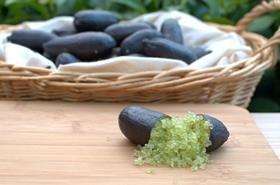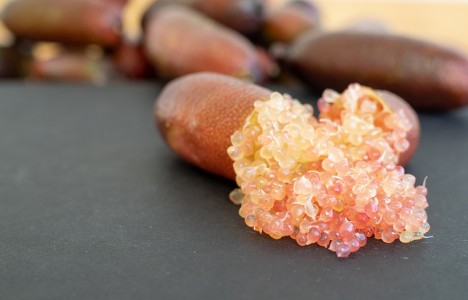
Why here? It’s the question at the forefront of your mind as Vladimir Zivkovic greets you from the gate of his finger lime orchard.
The small plantation springs out like a tropical oasis as you travel down a gated gravel road on a barren cattle farm in the north east corner of the Australian state of Victoria.
It’s just gone 9am and the mercury at the Boorhaman property is touching a barmy 32oC, a pleasant relief according to Zivkovi after a run of consecutive days above 40oC.
“Don’t worry,” he quips. “We get our cold days here too, in winter it can get down to -7oC.”
A quick survey of the landscape and you realise the extreme weather conditions ensure not much survives out here; some Eucalypts are dotted across the swamp flats that skirt the orchard’s western perimeter, while a herd of Herefords watches on from beyond the fence line as Zivkovic, or Vlad as he goes by, leads a tour through the orchard rows.
As he cuts into a piece of fruit to expose a bursting array of lime-scented vesicles, Zivkovic explains there are a few factors in his favour. A bore on the property provides a reliable water supply, which is meticulously delivered to the trees.
“What I’ve found is finger limes can easily be overwatered, they thrive in semi-dry conditions,” Zivkovic says. “I don’t pay anyone to look after the crop, I want to oversee it all myself, so I travel from Melbourne twice a week to water the trees.”

The isolation of the property means Zivkovic doesn’t have to contend with the same pest management issues faced by growers in northern New South Wales and southern Queensland, where the majority of Australia’s finger lime crop is produced. “The only insect I’ve seen out here is a grasshopper,” he explains.
Furthermore, the low humidity levels in Victoria are not conducive to the build-up of fungicides, a problem growers in other production areas commonly face.
Consequently, Zivkovic can produce a crop according to organic guidelines, with the fruit capable of being marketed as certified organic.
Still, the question lingers, why here?
“If you don’t take a risk you go nowhere,” explains Zivkovic, a Serbian-born horticulturist who was a leading authority on wine grapes in New Zealand before setting up the OZ Finger Limes operation eight years ago.
“If I don’t do this out here, I won’t know where the limits are for finger lime production.”

In essence, the orchard serves as a laboratory; a proofing ground for the varieties and techniques required to grow this unique crop in the harshest of conditions.
To date, a key focus for the OZ Finger Limes business has been the sale of plant material that has been tried and tested by Zivkovic. This programme is managed from a nursery in Melbourne.
This season will mark the first commercial-scale harvest of fruit from the Boorhaman orchard, which has over 4,000 trees planted across 25 varieties. The harvest period of mid-January to late May is around five weeks later than Queensland and New South Wales.
With Zivkovic planning to expand his production base to over 15,000 trees over the coming years, he has engaged Adrian Parsons of 160 Acres Group to market the fruit.
“There were many sceptics who said finger limes couldn't be grown in southern Australia due to the colder temperatures,' says Parsons. 'However, we have dispelled this myth thanks to Vlad’s specialised planting and fertilising methods, which are unparalleled in this sector.”
High in Vitamin C, folate, potassium and Vitamin E content, finger limes are often referred to as citrus or lime caviar. In Australia they are predominantly sold through the wholesale sector to customers in the foodservice industry, where they are commonly used as a garnish.
In a bid to lift consumer awareness, 160 Acres Group has developed the Zings brand for retail distribution, where the fruit currently has a relatively low profile. The brand has been designed to encapsulate the flavour profile of finger limes.
“I am very excited to assist Oz Finger Limes in carving out a niche for this fantastic native citrus crop, where a strong demand exists across both high-end restaurants and boutique retail outlets,' says Parsons. 'I am keen to make contact with interested distributors in both Australia and overseas as we launch our first commercial crop.”






No comments yet